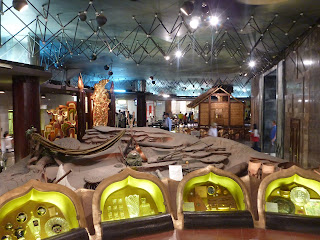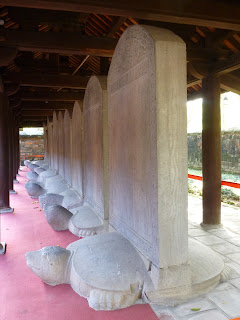Hanoi has quite a few good museums to offer, and so today I picked three of them to visit. When I arrived at the Ho Chi Minh museum in the morning, I discovered that the museum is part of a greater complex including his mausoleum and the house where he used to live. I had heard from people in my hostel that Ho Chi Minh was not currently in the mausoleum - apparently he is shipped off to maintenance once a year. I was all the more surprised to find a queue waiting at the entrance to the complex that, after a short wait, was guided directly to the mausoleum entrance:
Seems maintenance was done, and I was lucky enough to see the actual body of Uncle Ho! Visiting the mausoleum was an interesting experience. There were honor guards in white uniforms lining the entrance, the steps up to the burial chamber, and the chamber itself. We were guided through in single file; neither stopping nor photography were allowed. If anyone let the distance to the person in front of him become too big, he was ushered along by the guards. Ho Chi Minh himself looked very much like the pictures you can see everywhere - definitely not like a body that has been dead for more than forty years!
Once out of the mausoleum, the guards finally let everybody wander the complex on their own, and I got to visit the Ho Chi Minh museum. I had read that the museum would be odd, but this in no way prepared me for the reality of the museum's oddness. There were cars that seemed to be crashing through walls, wartime relics, sculptures, video installations and scenes from Ho Chi Minh's youth, all interspersed with lots and lots of letters and documents you could go through. This was only one of the many odd views in the museum:
Oddness aside, the museum was well done and I quite enjoyed visiting it. My next stop after this was the Fine Arts museum. It gave an excellent overview of Vietnamese arts, from its very beginnings until modern times. There was quite a bit of Buddhist art, of course, for example this statue who seems to be scratching his ear:
Among the more modern works, there were many done in lacquer. Next to silk paintings, lacquer work seems to be one of the typically Vietnamese (or Asian) techniques. I learned that lacquer is the extracted sap from the lacquer tree. The paintings done with lacquer are beautiful, often done with gold or silver color on a black background. This lady was therefore a somewhat untypical piece of lacquer artwork, having next to no black in it:
Many of the more recent works in the museum depicted some aspect of the war. This may well be due to the fact that that's what the ruling party decided to exhibit - especially because there were only paintings of glorious acts, or of the population's unwavering support of the wartime effort. Works of suffering and loss weren't really present - at least not that I can remember.
Just opposite the Fine Arts museum was the Temple of Literature. These buildings are said to have housed Vietnam's first university with a history of almost 1000 years. The Temple of Literature was the place people came to to prepare themselves for the national and royal exams that were held regularly. Today, people come here to pray for luck in upcoming exams, and to make pictures on graduation day. My visit seemed to coincide with a graduation day: there were girls in traditional dresses, boys in suits, and photographers carrying huge SLR cameras. I felt like I was walking into somebody's shot with every single step - but it seemed people were already used to that and kept friendly throughout.
The royal examinations were roughly at the level of a doctorate. The names of successful candidates were engraved on stone stelae which were standing on the backs of stone turtles, and then erected in one courtyard of the Temple of Literature. Today, these doctor's stelae are still there:
My last museum for the day was Hanoi's women's museum. The museum had three sections. The first floor explained typical events in a woman's life: marriage, childbirth, family life. Since Vietnam has more than 50 minority cultures, the museum did not only provide explanations for the mainstream culture, but also for several of the minority people, grouped into patrilineal and matrilineal cultures.
Many of the old marriage customs are still practiced today. I found it fascinating to learn more about who joins who's family, and how this exchange is somehow paid for in wedding gifts from one family to the other. Many of the exhibits were traditional wedding dresses, and also samples of the typical gifts exchanged. This, for example, is a mainstream Viet wedding outfit:
The most interesting part regarding childbirth were the different naming customs. In at least two minority peoples, the kid gets a say regarding the name he or she is going to receive. For this, the family relies on a ritual master. About a week after the birth, he is called to do some kind of ritual, and then say the intended name out loud. If the child cries upon hearing the name, a different name has to be chosen. I like the idea of the child being part of the naming decision, but I have slight doubts whether the child can be fully aware of the ritual's consequences at this young age. Plus, nobody bothers to explain the rules, so how should the kid know when to cry?
The second floor covered women in war, and this felt like propaganda again - especially because it had sections for women in both north and south before the war, and women in the north during the war, but conveniently left out women in the south during the war.
The third floor then had an exhibition of women's fashion across all the cultures in Vietnam. Something I didn't know before was that at some point it was considered beautiful for women to apply black lacquer to their teeth, like in this picture:
Today, the fashion has changed and only older women still have black teeth.
The museum's final exhibit was this gorgeous dress, in the typical traditional mainstream Viet fashion. These dresses combine long pants with a top/dress that has slits up to about the hip or navel on the sides. I really like these dresses: they look great, but are also very practical.








